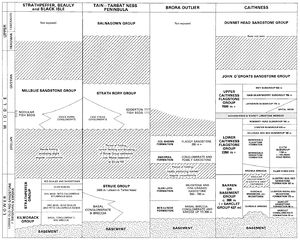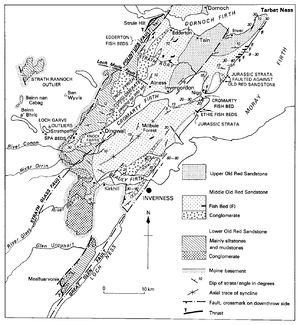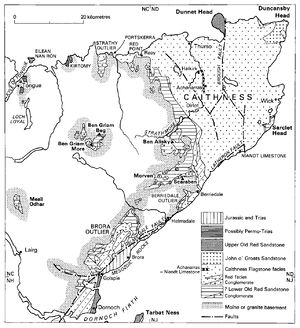Old Red Sandstone, Northern Highlands of Scotland
From: Johnstone, G S and Mykura, W. 1989. British regional geology: the Northern Highlands of Scotland (4th edition). (Nottingham: British Geological Survey.)
Introduction



Old Red Sandstone strata form an almost continuous outcrop along the eastern side of the Northern Highlands from Loch Ness to the north coast of Caithness. West of the main outcrop there are a number of small outliers which suggest that rocks of this age formerly extended westwards along certain pre-Devonian topographic depressions. In the south of the region sediments of Old Red Sandstone age form only one small outlier, on the west shore of Loch Linnhe.
It has long been held that only Middle and Upper Old Red Sandstone rocks are present in the Northern Highlands. In recent years, however, the lower part of the previously accepted ‘Middle Old Red Sandstone’ has been tentatively assigned to the Lower Old Red Sandstone (Westoll, 1951; Armstrong, 1964) and this interpretation has been supported by miospore evidence (Richardson, 1967; Collins and Donovan, 1977). The rocks ascribed to the Lower Old Red Sandstone consist of coarse basal breccio-conglomerates and conglomerates overlain by, and interdigitated with, a sequence of generally fine-grained sandstones, siltstones and mudstones (P915488). In Easter Ross the fine sediments are olivegrey, dark grey or black; around Strathpeffer bituminous rocks form an important part of the sequence. These Lower Old Red Sandstone sediments were involved in localised folding and thrusting, and affected by a period of subaerial erosion prior to the deposition of the Middle Old Red Sandstone.
The Middle Old Red Sandstone sediments exhibit a marked change of facies from mainly lacustrine flags in Caithness to predominantly fluvial sandstones and conglomerates in Easter Ross and Inverness-shire. The Caithness flagstones were laid down in an extensive shallow lake which extended northwards across Orkney. They contain many fish-bearing beds, the best known of which is the Achanarras Limestone. Easter Ross appears at that time to have been part of the flood plain of a large north-east flowing braided river bounded on its margins by alluvial fans. A few fish beds intercalated with the sandstone represent temporary transgressions of the Orcadian lake which lay to the north-east. The conglomerates on the west side of the Easter Ross outcrop contain pebbles of Torridonian and Cambrian rocks, which crop out in situ only west of the Moine Thrust.
Upper Old Red Sandstone crops out in the Tarbat Ness–Tain peninsula (P915487) and forms a narrow coastal strip north of Dornoch (P915486). Dunnet Head, Caithness, is part of a larger outcrop of Upper Old Red Sandstone which extends across the Pentland Firth to Hoy. In all these areas the sediment is a cross-bedded, locally pebbly, medium- to coarse-grained fluvial sandstone, probably laid down on large alluvial plains fed by rivers flowing from the west or south-west.
The terrain on which the Old Red Sandstone was deposited appears to have been mountainous in both Lower and Middle Old Red Sandstone times, with the relief being greatest in the west and south-west. The climate was tropical or subtropical; palaeomagnetic data suggest that in Devonian times Britain lay between 30°S and 10°S. Lower Old Red Sandstone sediments were laid down in isolated basins, the margins of which were, to some extent, controlled by faults which may have been active at the time of deposition. The Middle Old Red Sandstone basins were more extensive, and in parts of Caithness, around the Sutors of Cromarty, and in some of the western outliers, Middle Old Red Sandstone rests directly on the crystalline basement. The base of both the Lower and Middle Old Red Sandstone is markedly diachronous. The basal Lower Old Red Sandstone appears to be oldest in the area south and south-west of Strathpeffer, becoming progressively younger north-eastward towards Ousdale in southern Caithness. The base of the Middle Old Red Sandstone, on the other hand, appears to be oldest at Sarclet on the east coast of Caithness, where there is a conformable upward passage from the Lower Old Red Sandstone, becoming younger in both a north-westward and a south-westward direction.
The most problematical rocks of possible Old Red Sandstone age in the Northern Highlands are those forming the outliers at Kirtomy, Eilean nan Ron and Tongue in northern Sutherland (P915486; see Peach in Crampton and Carruthers, 1914). These rocks consist of conglomerates, and bright red sandstones and siltstones with poorly developed incipient cornstone horizons. The Finer sediments contrast strongly with the more compact dull purplish rocks of the outliers further east along the Sutherland coast. The Old Red Sandstone age of these western outliers has been questioned by Maclntyre and others (1956), who hinted at a possible Torridonian age, but the presence of pebbles of Durness Limestone, Cambrian Quartzite and Pipe Rock on the Ron Islands, and pebbles of Ben Loyal type syenite in the Tongue outcrops, rules out that possibility. Drill cores of similar red sandstones and conglomerates obtained by the Marine Geology Unit of BGS just offshore north of Sutherland have yielded poorly preserved spores of possible low Mesozoic age. Though Blackbourn (1981a; 1981b) and O’Reilly (1983) still regard the outcrops as Old Red Sandstone, they have produced no lithological or palaeontological evidence which would preclude a New Red Sandstone age.